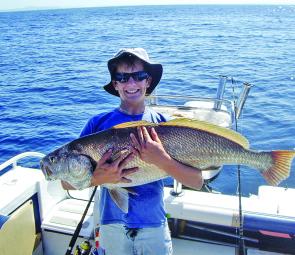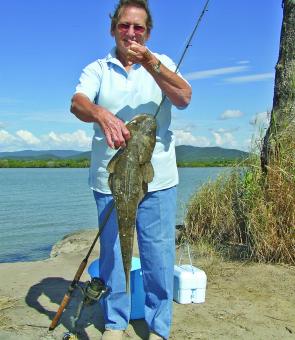The estuaries have been the only real option for most fishers lately with a run of 20 knot winds preventing trips offshore. But this means it’s a great time to get reacquainted with the bread and butter species and bream have been everywhere from the river, creeks, the headlands and all the islands.
As is normal, Port Alma has had the big fellas with some topping 2kg. The keen bream fishers take a variety of baits from mullet gut, fillets, yabbies, hardiheads, greenback herrings or lures. Plastics are every increasing in their popularity after watching the boys on TV having great success with them and they do work well for most types of estuary fish. They also have the added advantage of coming home clean and fresh after a day of fishing with plastics instead of coming home smelly and dirty from gathering and using bait.
In Central Queensland we get a couple of fairly good estuary grunter runs during the year. Though it is not in the same league as Kowanyama’s South Mitchell or Topsy Creek, for a populated area we get some pretty good fish. They school up in the deeper holes of The Fitzroy, Coorooman Creek, The Causeway, Fishing Creek and Waterpark Creek.
I have been trying to catch estuary grunter on plastics for a couple of seasons with limited success until now, in spite of offshore grunter taking plastics readily. I tried too hard to entice them like I would bream or flathead and it just wasn’t working. Getting a grunter to strike doesn’t take the same amount of finesse that the bream and bass boys have developed and I think that was where we were going wrong.
On a recent run down from Corbett’s landing to Corio Bay, my mate Thommo and I tried every conceivable technique known to man to try and catch as many different species as possible. The effort paid off with one of the best tallies we have scored in that system. We caught a few barramundi, cod, bream, flathead and more than 20 grunter all on plastics. We released most of the fish too, keeping just enough for a feed. The day was wet and windy making it difficult to target any particular area for any length of time. So with the aid of the electric we worked every structure and feature down and on the way back up Waterpark Creek to the boat ramp.
On the day we both had the most success with atomic prongs that matched the live prawn colouring. These lures scored well on all the fish except the grunter. Still wanting to nail some grunter we checked out which species of baitfish were thickest in the creeks at the time and came up with hardiheads. We both had some different plastic hardies, Thommo used Squidgies and I had a pack of Bozos. Both types ended up catching fish, but the Bozos were unbeatable on the day.
Waterpark has a few grunter patches that, to the average fisher, seem to have very little resemblance to other good spots in the area. But by turning up the zoom on the sounder the gravel and cockle beds show up very well. In the end success came when we worked the plastic hardies from the shallow gravel banks down into the deeper mud holes.
Don’t be afraid to let your jigs sit on the bottom for a second or two between flicks and even let it settle back in the same spot if you can. We found that once a grunter was hooked others came to investigate and grabbed the second lure almost every time. We went back down the creek and tried the same methods again and again scoring enough fish each time to finally be confident that anytime grunter are in the creek we can now get them on plastics.
The moral of the story is: when you know fish are there keep trying different retrieves, lures, depths and baits until you find the one that works. Too many times people try their usual method, fail, and then go home and say there wasn’t any fish. With some persistence and various techniques, the outcome might be different. Never be afraid to do something others might think is stupid because if it works, you’re the hero and if not, you’re no worse off for the experience.
The last month we had limited good weather, but there were still a few top fish captured. The red fish and coral trout again topped the catch ladder with Spanish mackerel and grunter moving up. Black jew also appeared in better numbers after a slow start to the season. They started coming in small schools and only the odd fish was caught before the last full moon when quantities increased dramatically. Most locals know the jew are congregating to breed and only take a fish or two and release the rest of their captures.
Two of the main black jew schools are at Corio Heads and Ironpot. Both of these spots are close to shore and are easily accessible for the average small boat owner. The Pinnacles and Cape Capricorn are also fishing well, but being that bit further away a bigger boat is necessary.
The school mackerels have been in short supply because of the conditions in the bay so we are all hoping a few glassy, winter days will turn the table and maybe a few dogs and greys will come in again. Remember fog means mackerel, anytime there is fog there is mackerel to be caught.
Lately up and down the coast there has been quite a few red bass landed by reef fishers who thought they were mangrove jacks. I received a couple of emails asking for an ID on these top-looking fish. A pair of lads from Tweed recently caught a nice size red bass offshore and when Norton bought it into the boat he thought he had his biggest jack ever, until he was informed it was a red bass. There was a hint of a tear in his eye as he put it back in the water. The easiest way for me to tell it a red bass from a jack is the yellow eyes and the divot in front of the eye.
If you ever catch a fish and are unsure what the species is, it can be tempting to put the fish in the icebox to try to identify it back on land. But resisting this temptation and releasing the fish is the best option, as it may be under size or a banned species.
Reads: 5341
Andrew Wilson landed this fine black jew out from Yeppoon.

Dale Norton from Tweed caught this fine red bass offshore, he first mistook it for a massive mangrove jack.

Jason Large with a Keppel caught spanno.

Val Duffill caught this nice 2.5 kg flathead at Coorooman on Mother's Day.




